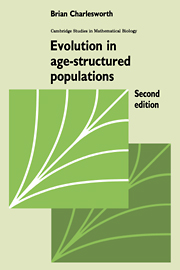Book contents
- Frontmatter
- Contents
- Preface
- Preface to the second edition
- 1 Models of age-structured populations
- 2 The genetics of populations without selection
- 3 Selection: construction of a model and the properties of equilibrium populations
- 4 Selection: dynamic aspects
- 5 The evolution of life-histories
- Appendix 1 Generating functions and their properties
- Appendix 2 Asymptotic values of ρpi and 2ρi
- References
- Author index
- Subject index
2 - The genetics of populations without selection
Published online by Cambridge University Press: 18 December 2009
- Frontmatter
- Contents
- Preface
- Preface to the second edition
- 1 Models of age-structured populations
- 2 The genetics of populations without selection
- 3 Selection: construction of a model and the properties of equilibrium populations
- 4 Selection: dynamic aspects
- 5 The evolution of life-histories
- Appendix 1 Generating functions and their properties
- Appendix 2 Asymptotic values of ρpi and 2ρi
- References
- Author index
- Subject index
Summary
Introduction
In Chapter 1, the basic concepts of mathematical demography were introduced. We shall start to apply these concepts in the present chapter to the genetics of age-structured populations. The cornerstone of population genetics theory is the Hardy–Weinberg law, which deals with a population which is not exposed to the action of any of the standard evolutionary forces: mutation, migration, selection, non-random mating, or random sampling of genes due to finite population size. In such a population, a single autosomal locus reaches an equilibrium with constant gene frequencies, and in which genotypic frequencies are predicted from the gene frequencies by the familiar Hardy–Weinberg formula (Crow and Kimura, 1970, Chapter 2). This result is conventionally derived for the case of a discrete-generation population, where gene frequencies can be shown to remain constant for all time, under the stated assumptions, and in which Hardy–Weinberg frequencies are reached after one generation. There have been a few attempts to extend this result to more general types of populations. Moran (1962, Chapter 2) gave a treatment of a continuous-time model which assumed constancy of gene frequencies for all time. Charlesworth (1974b) showed that gene frequencies become asymptotically constant, using a continuous-time model; he gave a proof for a discrete age-class model with time-independent demographic parameters in Jacquard (1974, Chapter 7). This case has also been studied by Gregorius (1976).
In the first part of this chapter, we shall be concerned with the analysis of the approach to genetic equilibrium in the absence of evolutionary factors, using both discrete age-class and continuous-time models. The cases of a single autosomal locus, a sex-linked locus and two autosomal loci will each be studied.
- Type
- Chapter
- Information
- Evolution in Age-Structured Populations , pp. 62 - 104Publisher: Cambridge University PressPrint publication year: 1994



